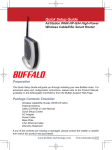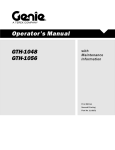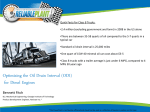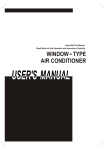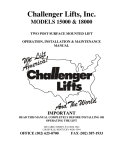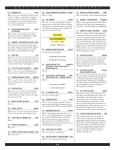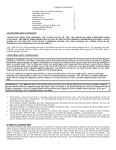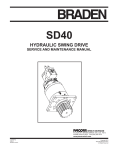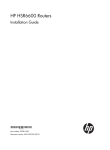Download Lubrication Oils & Grease
Transcript
Commercial Products Lubrication Oils & Grease PART NO. 99040SL This page is intentionally blank. Lubricants - Oil and Grease 1 Table of Contents Oil .................................................................................................................................... 2 Biodegradable Oil ............................................................................................................ 7 Grease........................................................................................................................... 10 Storage .......................................................................................................................... 12 Use of This Manual The information contained in this manual is supplementary to material found in other sources, it is not a replacement for them. You should always consult Service Manuals, Service Bulletins, Operator’s Manuals and Parts Books when necessary. Service Manual Updates and Service Bulletins can be found on the internet at: www.toro.com/golf/custsvc.html This Manual and the training program, which it supports, are both designed to help you gain knowledge of the product, and to inform you of when and why to make the necessary repairs. We have also included tips for performing those repairs. This program is designed for you. Your input and participation is appreciated. There is plenty of space in this manual for you to add your own notes and observations TORO ® Service Training 2 Lubrication - Oil and Grease Lubrication is important to the long term life of the equipment. Lubrication A thorough understanding of oils and greases will help you make the proper choices. Oils & Grease Commercial Products Oil is Oil, Grease is Grease • A few things to consider. – Automobiles use 30% of their available horsepower. – Trucks use 60% of their available horsepower. – Off road equipment uses 90% of their available horsepower. – Off road equipment demands lubricants designed for heavy duty performance. Turf equipment operates under more severe conditions then your average automobile or over the road truck. This means that the selection of lubricants is more important for this category of equipment then others. Source : Viscosity Oil Company What Is Oil? • Roughly 85% of the oil is “Base Oil”. – Often referred to as “Bright Stock”. • About 15% is the additives. – This is what makes a hydraulic oil different from an engine oil. Hydraulic or Engine oil is made of roughly 85% base oil. This base oil is the same. The 15% of the oil that is the additives is what make the oil a hydraulic or engine oil. Source : Viscosity Oil Company TORO ® Service Training Lubricants - Oil and Grease Typical Additives • Hydraulic Oil – Rust Inhibitors – Oxidation Inhibitors – Anti-wear – Anti-Foam – Pour point Depressant • Engine oil – Detergents – Dispersants – Corrosion Inhibitors – Anti-wear • Zinc Dialkyldithiophospate – Anti-Oxidant – Anti-Foam – Pour point Depressant 3 The typical additives to oil are rust inhibitors, oxidation inhibitors, anti-wear inhibitors etc… It is these additives that give the oil the required lubricating and service qualities to meet the requirements for the intended application. Source : Viscosity Oil Company Lubricants can fail for a variety or reasons. Why does a lubricant fail to lubricate Oils lose their desired properties L u b r ic a n t P r o b l e m Oxidation Control Rust Inhibition Why What Happens Inhibitors used up, stopping attack Oil Viscosity increases; deposits on oil and additives form. Acids corrode metals Inhibitors used up protecting iron surfaces Dispersancy Oil can't continue to protect against with metal surfaces, or removed by scuffing water. Dispersant becomes overloaded with liguid and solid contiminants This can be noticed by an increase of oil viscosity, deposits may form and/or acids may begin to corrode the metal parts. Oil fails to protect against further rusting. Additives consumed by reaction Load Carrying They can lose their ability to resist oxidation. This is caused when the additives to control oxidation are used up. Solids (varnish, sludge) form Rust inhibitors are used up and the metal is not protected from further rusting. The oil may lose its ability to protect the metal components from damage caused by heavy operational loads. The additives that keep contaminants in suspension can also be used up. Most of these additives are consumable additives. That means that in the course of doing their job they are consumed or depleted. Oil can also become contaminated with solid debris. Why does a lubricant fail to lubricate They become contaminated L u b r i c a n t P r o b le m Why W h a t Ha p p e n s This can include dirt, wear metals, rust, carbon from overheated oil or sludge and varnish. Sludge and varnish is caused as the oil begins to oxidize and deteriorate. Solids Dirt Dirt comes from everywhere Promotes wear, taxes lubricant properties A sign of an unhealthy machine Shortened machine life unless corrected Rust Oxygen, water and iron have interacted Contributes to wear. Carbon matter The oil has been overheated Deposits clog oil passageways Oxidation products have b e c o m e Deposits form on machine parts insoluble and control valves W ear Metals Sludge and varnish TORO ® Service Training Most of these contaminates can be controlled or removed through the use of proper filtration. 4 Lubrication - Oil and Grease Why does a lubricant fail to lubricate They become contaminated L u b r ic a n t P r o b le m Why What Happens A s ign of leaky seals or A ffects lubricant effeciency; condensation promotes oil deterioration E x c e s s i ve s y s t e m t e m p e r a t u r e s forerunner of m o re solid debris L ig u id s W ater Oxidation products Other lubricating oils Can alter desirable properties of M issapplication of oil on hand Lubricant suppliments Water can come into a system through external seal or gasket leakage, or through condensation. Water contamination is probably the most common contamination problem. system lubricant Usually added by well meaning Can alter desirable properties of servicemen system lubricant It is the additive breakdown and the liquid contamination that really drives the oil change interval because to a certain extent the solid contamination can be controlled. The ability of the oil to protect bearings, decreases rapidly as water accumulates in the oil. From .01% to .02% water the life remaining drops by 1/2. Effects of Water in oil on Bearing Life 250 200 150 100 Bearing Life 50 For this reason it is important to control the water content in the oil and change oil when water contamination is evident. 1 2 5 0. 0. 0. 08 0. 04 06 0. 0. 02 0. 00 25 0 0. % Bearing Life remaining Liquid contaminates can pose more of a problem. They are usually not easily removed through the filtration process. These contaminates may include; water, oxidation products, other lubricating fluids, or lubricant supplements. % Water in the Oil Effect of water in oil on bearing life(based on 100% life at .01% water in oil) Reference: “Machine Design” July 86, How Dirt And Water Effect Bearing Life” by Timken Bearing Co. Can different oil be mixed in the same system? • No – Different manufacturers may use different additives for wear or anti-foam etc... – These additives may not be compatible with the additives in the other oil. – An example, One anti-wear additive may render another anti-foam additive useless. Under normal circumstances different oil should not be mixed. The additives in one oil may not be compatible with the additives in the other oil. This can make one or more of the additives ineffective. TORO ® Service Training Lubricants - Oil and Grease 5 With multi-grade oil the base oil is the lower number. Multi-grade Oils • The Base oil is always the lower number. • Polymers are added. – The oil is a 10wt when cold. – Polymers make oil act like a 30wt when hot. The higher number in the oil rating is the weight oil that the oil performs like when hot. The oil does not get thicker when hot. It just does not thin out as much. The viscosity enhancers are actually microscopic plastic polymers. Viscosity Enhancers • Cold Oil – Polymers coil up to take up less space. • Warm oil – Polymers Un-coil up to take up more space. These polymers uncoil as they get hot and take up more space. It is these polymers changing that gives the oil it's different temperature characteristics. As a multi-grade oil begins to break down, these polymers will shear and the viscosity will decrease. Polymer Shear • As the engine oil breaks down these Polymers begin to fatigue and tear. • The upper weight of the oil will decrease. • It is important that the oil change intervals be followed. TORO ® Service Training It is important that the oil change intervals be followed when using multi-grade oils. 6 Lubrication - Oil and Grease When purchasing oil the oil ratings on the oil is an important source of information. Oil Ratings The top of the label gives the service classification of the oil. The top of the symbol shows the oil performance level. The Center of the symbol shows the oil’s SAE viscosity grade. The Bottom of the symbol shows if the oil has any energy conserving properties. The center of the label lists the oil weight, and the bottom lists if the oil has any energy conserving properties. The current service category for gas engine oil is SJ. Gasoline Engine Oil Service Categories Category Status Service SJ Current Indroduced as a API service symbol in 1996. For all automotive engines presently in use SH Obsolete For all model year 1996 and older engines SG Obsolete For 1993 and older engines SF Obsolete For 1988 and older engines SE Obsolete For 1979 and older engines SD Obsolete For 1971 and older engines SC Obsolete For 1967 and older engines SB Obsolete For older engines. Use only when specifically recommended by manufacturer SA Obsolete for older engines; no performance requirement Use only when specifically recommended by manufacturer The SJ rating replaces all the earlier ratings. For diesel engine oil the most common rating is CF. The rating replaced all previous diesel oil ratings. Diesel Engine Oil Service Categories Category Status Service CF Current Introduced in 1994 for off-road, Indirect-injected and other diesel engines, including those using fuel over 0.5% weight sulfur. Can be used in place of CD oils CE Obsolete Introduced in 1987. For high-speed, four-stroke, naturally aspirated and turbocharged engines. Can be used in place of CD oils. CD Obsolete Introduced in 1955. For certain naturally aspirated and turbocharged engines CC Obsolete For engines introduced in 1961 CB Obsolete For moderate duty engines from 1949 to 1960 CA Obsolete For light duty engines (1940's and 1950's) There have now been some changes in the diesel engine oil classifications. Several new categories have been introduced. TORO ® Service Training Lubricants - Oil and Grease New Diesel Engine Oil Service Categories Category Status Service CH-4 Current Introduced December 1, 1998. For high-speed, four-stroke engines designed to meet 1998 exhaust emmission standards. CH-4 oils are specially for use with diesel fuels ranging in sulfur content up to 0.5% weight. Can be used in place of CD, CE, CF-4, and CG CG-4 Current Introduced 1995. For high-speed, four-stroke engines using diesel fuel with less then 0.5% weight sulfur. Can be used in place of CD, C E , CF-4 oils CF-4 Current Introduced in 1990. For high-speed, four-stroke, naturally aspirated and turbocharged engines. Can be used in place of CE oils. CF-2 Current Introduced in 1994. For severe duty, two-stroke-cycle engines. Can be used inplace of CD-II oils 7 With all the new emission requirements there have been several new categories added for diesel engine oil. These oils are more specifically rated for various engines. There is increasing interest in the use of biodegradable oil in turf mowing equipment. Lubrication Biodegradable Oil Commercial Products Biodegradable Hydraulic Fluid Mobil EAL 224H approved in selected Toro equipment System must be Double Flushed TORO ® Service Training The only biodegradable hydraulic oil that is currently approved for use in Toro equipment is the Mobile EAL 224H. When a system is changed over to biodegradable oil, the system must be double flushed before the unit is put into service with the biodegradable fluid. 8 Lubrication - Oil and Grease When oil is spilled or leaks in the shop, the spill does not pose a serious problem. However, when oil is leaked on a fairway or green, the results can be more severe. There are issues of the grass being killed and the soil being contaminated. Patches of damaged turf can be readily seen after a loss of hydraulic fluid. The use of biodegradable fluid will not prevent the grass from being damaged or killed. The high temperature of the oil can kill the turf on it’s own. However, the advantage of the biodegradable fluids is that the recovery time can be shorter because the soil is not contaminated. TORO ® Service Training Lubricants - Oil and Grease 9 The grass will come back faster then if the damage was caused by a regular petroleum fluid. This chart shows some of the recovery times for grass when a petroleum spill is encountered. Biodegradable Hydraulic Fluid TORO ® Service Training The current biodegradable fluids that are available are not approved for use in mechanical drive trains, or in units that use the mechanical drive train for the hydraulic reservoir for the system. 10 Lubrication - Oil and Grease There is a hydraulic oil dye, Toro PN. 44-2500 that is available to help you find hydraulic oil leaks. The proper selection and usage of grease can greatly improve the life of your equipment. Grease Selection and Application Commercial Products Grease is expected to reduce friction and wear. Provide protection against corrosion. Grease • Grease is expected to: – Reduce friction and wear. – Provide corrosion protection. – Resist leakage, dripping and throw-off. – Maintain mobility under conditions of application. – Be compatible with seals. – Tolerate or repel moisture. Resist leakage, dripping and throw-off. Grease must maintain mobility under all the conditions that the equipment operates under. Grease must be compatible with seals. And it must tolerate or repel moisture. All of these requirements make the proper selection of grease important. TORO ® Service Training Lubricants - Oil and Grease 11 Grease is made up of approximately 75 to 90% oil. Grease Since the oil is such a large part of the final grease product, a good quality oil must be used. • What is Grease – 75 - 90% oil • The High percentage of oil requires that it be a high quality lubricating oil. Between 5 and 20% of the grease is thickeners. Grease – 5 - 20% Thickener • Common Thickeners are –Calcium –Lithium –Sodium • When you hear about Lithium base greases, that refers to the thickening component. Grease – 0-15% Additives • Oxidation inhibitors – Prolongs the life of the grease. • EP Agents – Guards against Scoring and Galling. • Anti-Corrosion Agents. – Protect metal against attack from water, sulfides or corrosive elements. • Anti wear agents. – Prevent abrasion and metal to metal contact. TORO ® Service Training These thickeners have some very specific properties and they will affect the overall performance of the grease. One of the most common thickeners is Lithium. The remaining additions to the grease are additives that improve the overall protecting qualities of the grease. 12 Lubrication - Oil and Grease Grease selection is important. Grease selection P roperties C a lcium Lithium Sodium D ropping Point 175-212°F 345-400°F 340-390°F Max Temp 150°F 260°F 260°F High temp use V e ry P o o r Good Good L o w te m p mobility Fair Good Good Mech. S tability Fair Good Fair W a ter R e s tance E xc. Good Fair Oxidation S tability Poor Good Poor S m o o th Fibrous or S m o o th Texture S m o o th Greasing Practices • How you grease is as important as which grease is used. – “Water contamination can cut bearing life by as much as 80%”. Source: Noria Corporation – There are two main things that need to be done to control the water problem. • Keep the water out in the first place. – Manufacturers • Remove it before it can do harm. – Maintenance Personnel This chart shows the three main types of common greases. The chart shows that the Lithium greases perform about the best in all of the important categories. How and when you grease is as important as what you grease with. Water contamination is one of the most common things that happens to a greased component. In order to maintain the proper life from the bearings, this water must be flushed from the component. When the unit is greased, it should be greased after the unit is washed and before it is put away for the day. Greasing purges the water from the component and this water should be removed before the unit is taken out of service. Lubricant storage • Select proper containers and quantities. – New, sealed oil containers should be used within 1 year. – Unopened grease should be used within 6 months. • Purchase lubricants in the proper quantities. Another factor that comes into play is the proper storage of lubricants. Sealed new containers of oil should be used within one year. Unopened grease should be used within 6 months. This requires you to purchase your lubricants in the proper quantities. Opened containers will keep approximately half as long as unopened containers. TORO ® Service Training Lubricants - Oil and Grease Lubricant storage • Lubricants should be stored in-doors. – Keep containers closed when not in use. – Label and date all lubricant storage containers. • Received and opened date. • If outside storage is required, do not store containers upright. – This prevents water from entering container. TORO ® Service Training 13 Whenever possible, lubricants should be stored indoors. This will help prevent water getting into the container. This is especially important for containers that have been opened. If the containers must be stored outside, do not store them in an upright position, or be sure to cover them. The Toro Company
















